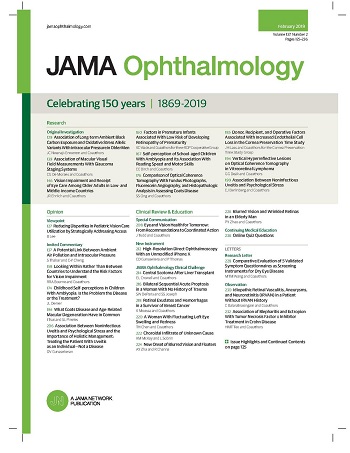Metformin and the Development of Age-Related Macular Degeneration.
IF 9.2
1区 医学
Q1 OPHTHALMOLOGY
引用次数: 0
Abstract
Importance Metformin has demonstrated protective effects in systemic diseases, including cancer, cardiovascular disease, and retinal diseases, such as diabetic retinopathy and choroidal neovascularization. Literature suggests metformin may reduce the risk of age-related macular degeneration (AMD), but a consensus has not been reached. Objective To evaluate the association of metformin with the development of any AMD and progression to geographic atrophy and neovascular AMD using a large electronic health record (EHR) platform. Design, Setting, and Participants This cohort study had 2 exposed cohorts of participants aged 65 years or older who were prescribed metformin: one without AMD to assess development of any AMD and the other with mild or moderate nonexudative AMD to evaluate AMD progression to geographic atrophy or neovascular AMD. Corresponding nonexposed cohorts consisted of participants not prescribed metformin. Participants were required to meet inclusion criteria at least 6 months before the outcome of interest occurred. Those who had outcomes of interest before meeting inclusion criteria were excluded from analysis. This cohort study used a federated health research platform aggregating deidentified EHR data from 70 institutions (TriNetX). Data were collected from January 2013 to June 2025 and analyzed from September 2024 to June 2025. Exposures Participants prescribed metformin. Main Outcomes and Measures Propensity score matching controlled for confounders, such as age, sex, race, hypertension, diabetes, and other systemic conditions. Risk ratios (RRs) with 95% CIs were calculated to compare outcomes at 5 years, 10 years, and any time after meeting criteria. Any confidence intervals that crossed 0.90 to 1.10 were considered statistically not significant. Comparisons between exposed and unexposed groups were repeated requiring a diagnosis of cataract. Results Before propensity score matching, cohort 1 (no AMD) included 297 008 participants exposed to metformin (mean [SD] age, 74.9 [7.0] years; 157 584 [53.1%] female) and 1 269 644 participants unexposed to metformin (mean [SD] age, 76.8 [7.9] years; 738 640 [58.2%] female). Before propensity score matching in cohort 2 (early or intermediate nonexudative AMD), there were 12 843 participants exposed to metformin (mean [SD] age, 79.5 [7.2] years; 7107 [55.3%] female) and 77 279 participants unexposed to metformin (mean [SD] age, 81.6 [7.2] years; 48 491 [62.7%] female). After propensity score matching, participants prescribed metformin had comparable risk of developing any AMD relative to those not prescribed metformin (RR, 0.90; 95% CI, 0.86-0.94). When stratified by time, the risk remained similar at 5 years (RR, 0.94; 95% CI, 0.90-0.99) and 10 years (RR, 0.91; 95% CI, 0.87-0.94). Similarly, participants prescribed vs not prescribed metformin had a comparable risk of AMD progression over these time spans (RR for geographic atrophy, 0.87; 95% CI, 0.76-1.01; RR for neovascular AMD, 1.03; 95% CI, 0.91-1.17). Conclusion and Relevance This study suggests that, overall, metformin is not associated with significant development or progression of AMD. Further studies and prospective analyses are necessary to evaluate whether dosage and longevity of metformin use are associated with AMD development or progression.二甲双胍与老年性黄斑变性的发展。
二甲双胍已被证明对全身性疾病有保护作用,包括癌症、心血管疾病和视网膜疾病,如糖尿病视网膜病变和脉络膜新生血管。文献表明,二甲双胍可以降低老年性黄斑变性(AMD)的风险,但尚未达成共识。目的利用大型电子健康记录(EHR)平台评估二甲双胍与任何AMD的发展、进展到地理萎缩和新生血管性AMD的关系。设计、环境和参与者本队列研究有两个暴露的队列,参与者年龄在65岁或以上,处方二甲双胍:一组没有AMD以评估任何AMD的发展,另一组有轻度或中度非渗出性AMD以评估AMD进展为地理萎缩或新生血管性AMD。相应的非暴露队列包括未开二甲双胍处方的参与者。参与者被要求在结果发生前至少6个月符合纳入标准。那些在符合纳入标准之前有相关结果的患者被排除在分析之外。这项队列研究使用了一个联邦健康研究平台,汇总了来自70家机构(TriNetX)的已确定的电子病历数据。数据收集时间为2013年1月至2025年6月,分析时间为2024年9月至2025年6月。参与者服用二甲双胍。主要结果和测量方法倾向评分匹配控制混杂因素,如年龄、性别、种族、高血压、糖尿病和其他系统性疾病。计算95% ci的风险比(rr),比较5年、10年和满足标准后任何时间的结果。任何超过0.90到1.10的置信区间都被认为在统计学上不显著。反复比较暴露组和未暴露组,要求诊断白内障。结果在倾向评分匹配前,队列1(无AMD)包括297 008名二甲双胍暴露者(平均[SD]年龄74.9[7.0]岁;157 584[53.1%]女性)和1 269 644名二甲双胍暴露者(平均[SD]年龄76.8[7.9]岁;738 640[58.2%]女性)。在队列2(早期或中期非渗出性AMD)的倾向评分匹配之前,有12 843名暴露于二甲双胍的参与者(平均[SD]年龄79.5[7.2]岁;7107[55.3%]名女性)和77 279名未暴露于二甲双胍的参与者(平均[SD]年龄81.6[7.2]岁;48 491[62.7%]名女性)。倾向评分匹配后,处方二甲双胍的参与者与未处方二甲双胍的参与者相比,发生任何AMD的风险相当(RR, 0.90; 95% CI, 0.86-0.94)。当按时间分层时,风险在5年(RR, 0.94; 95% CI, 0.90-0.99)和10年(RR, 0.91; 95% CI, 0.87-0.94)时保持相似。同样,服用二甲双胍与未服用二甲双胍的参与者在这些时间跨度内AMD进展的风险相当(地理萎缩的RR, 0.87; 95% CI, 0.76-1.01;新生血管性AMD的RR, 1.03; 95% CI, 0.91-1.17)。结论和相关性本研究表明,总体而言,二甲双胍与AMD的发生或进展无关。需要进一步的研究和前瞻性分析来评估使用二甲双胍的剂量和寿命是否与AMD的发生或进展相关。
本文章由计算机程序翻译,如有差异,请以英文原文为准。
求助全文
约1分钟内获得全文
求助全文
来源期刊

JAMA ophthalmology
OPHTHALMOLOGY-
CiteScore
13.20
自引率
3.70%
发文量
340
期刊介绍:
JAMA Ophthalmology, with a rich history of continuous publication since 1869, stands as a distinguished international, peer-reviewed journal dedicated to ophthalmology and visual science. In 2019, the journal proudly commemorated 150 years of uninterrupted service to the field. As a member of the esteemed JAMA Network, a consortium renowned for its peer-reviewed general medical and specialty publications, JAMA Ophthalmology upholds the highest standards of excellence in disseminating cutting-edge research and insights. Join us in celebrating our legacy and advancing the frontiers of ophthalmology and visual science.
 求助内容:
求助内容: 应助结果提醒方式:
应助结果提醒方式:


